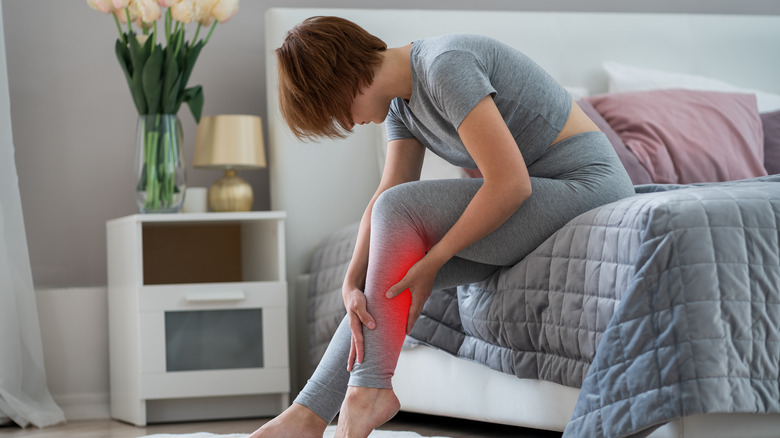What Causes Calcium Deposits In The Skin & How Can You Treat Them?
Calcium deposits in the skin are referred to medically as calcinosis cutis (per DermNet). It's a condition where small white or yellow nodules or papules (bumps) appear on the skin's surface. They're usually hard to the touch and can appear anywhere on the body but are mostly harmless. However, they may appear on joints where they restrict movement or on the fingertips where they cause pain.
Calcium deposits aren't to be mistaken for skin milia, which though similar, being small white spots, aren't actually formed of calcium but of keratin. Calcinosis cutis, on the other hand, is mainly composed of calcium salts, such as calcium phosphate and, sometimes, to a lesser degree, calcium carbonate.
The reason why these deposits develop, as we will discuss, varies depending on what type of calcinosis cutis you have. However, generally speaking, the primary causes are due to metabolic reasons or localized tissue damage due to skin injury or trauma. When metabolic factors are involved, it may be caused by conditions that affect the whole body, such as those that compromise the immune system, or when our body is responding to nutritional changes. Learn what calcium deposits are and how to deal with them, so you'll be prepared should they pop up on your face or body.
What are calcium deposits?
Calcinosis cutis is when calcium salts settle in and under the skin, but there are actually five subtypes of calcium deposits (per "Calcinosis Cutis"), which characterize how and why deposits appear — dystrophic, metastatic, idiopathic, iatrogenic, and calciphylaxis. The main difference between how these types are diagnosed depends on whether a person has elevated calcium or phosphate levels.
For instance, if a person has normal calcium levels, it means they have either a dystrophic or idiopathic subtype. If levels are elevated, it suggests one of the latter three. The most common type, dystrophic calcinosis cutis, is associated with autoimmune diseases, but it can be caused by infections, tumors, or trauma. The idiopathic subtype can happen to anyone, and the cause is still unknown.
The metastatic subtype usually happens due to high calcium or phosphate in the body. This might be from diet, such as excessive vitamin D or calcium intake. It also might occur if a person has a condition that inhibits their body's ability to process nutrients, such as with thyroid conditions or kidney failure. The iatrogenic subtype may occur due to treatments that inadvertently elevate calcium or phosphate levels. Lastly, calciphylaxis, described in a review in the Journal of the American Academy of Dermatology, is the most severe and rare subtype, where calcium deposits begin in the blood vessels and sometimes cause serious infections. In most cases, calcinosis cutis is typically benign, with problems only occurring if there's an underlying medical issue.
Medical conditions that can cause calcium deposits in the skin
One of the main concerns around calcium deposits in the skin is that since the dystrophic subtype is the most common, it can mean there is a pre-existing connective tissue disorder. These diseases affect how the body's connective tissues (namely collagen and elastin) are structured. In most cases, this is because these disorders come from a compromised immune system where the body mistakenly attacks its own tissues.
The most common connective tissue disorders that can cause calcinosis cutis, according to research in the Journal of Rheumatology, include lupus, scleroderma, or dermatomyositis. As this research explains, 18% to 49% of scleroderma patients and 30% of dermatomyositis patients will suffer from calcium deposits in the skin. While the exact reason for this is unclear, scientists suggest that it may have to do with how these diseases can affect blood flow and oxygen in the blood or the onset of inflammation, which is common in autoimmune connective tissue diseases.
In addition, those with the metastatic subtype might also be more likely to have calcium deposits in the skin if they suffer from conditions that elevate their calcium or phosphate levels (per Medscape). These conditions affect how well the body can metabolize these nutrients: bone diseases, sarcoidosis, and kidney dysfunction.
Injuries that can cause calcium deposits in the skin
There are a few different sources of trauma that can elicit calcium deposit development. For the most part, dystrophic calcinosis cutis is defined by tissue damage, wherein dying cells release phosphate-binding proteins. These proteins contain calcium, and when they bind to phosphate, they become calcium phosphates, which we saw are the main components of calcium deposits.
In part, older research by the Journal of the American Academy of Dermatology suggests this may be because the mitochondria in our skin, which help to break down nutrients and power our cells, have a high affinity for calcium and phosphate. As a result, they attract these nutrients, causing them to crystallize and become hard, which of course, causes more damage, exacerbating the formation of more deposits.
There are a few types of damage that might instigate this cycle. For instance, research (in the Journal of the American Academy of Dermatology) points to sun damage, or where the skin has been punctured in the same place multiple times (such as with IV), excessive skin friction caused by skin folds, and repeated bruising or scarring as potential sources of calcinosis cutis. They suggest that such instances damage the elastin (elastic proteins) and collagen in our skin, which may lower our ability to resist calcium deposit buildups.
Genetics and calcium deposits in the skin
There's some evidence presented in the Journal of the American Academy of Dermatology that there is a genetic component to developing calcium deposits in the skin, the main factor in this is if a person has an inherited disorder, such as PXE (Pseudoxanthoma elasticum), Werners syndrome, or Ehlers-Danlos syndrome. These are usually diseases where gene mutations are passed between family members and make an individual more likely to suffer from calcinosis cutis.
Additionally, some people may be prone to calcium deposits due to genetic factors, even if they do not have a specific underlying condition. To explain, a study in the journal Immuno shows that people who have some kind of immune system dysfunction may be more susceptible to getting calcium deposits because of the abnormal reaction their body undergoes in response to pathogens or other harmful agents.
For instance, as a response to a virus, people with these kinds of dysfunctional immune systems might develop specific antibodies which mistakenly attack the body's own tissues and organs. The damaged or inflamed tissues then cause calcinosis cutis. In other words, the presence of these specific antibodies might not mean a person will get the condition, but they can signal an underlying immune system disorder, which increases the risk of calcium deposits forming.
Medications that can cause calcium deposits in the skin
While uncommon, there's some evidence that certain treatments or medications can play a role in calcium skin deposits. This is often the case with the iatrogenic calcinosis cutis subtype, which, if you remember, can occur because of medical therapies that inadvertently elevate calcium or phosphate levels.
For instance, there have been cases, such as one in the journal Cureus, where a patient has received an injection of a calcium-containing solution, usually for treating another condition, which has caused the development of calcium deposits. They highlight that these injections can raise the level of calcium in the bloodstream by up to 100 times more than the amount of treatment substance that is administered. And the writers believe this effect may be due to the fact that damaged skin tissues are more likely to be prone to calcium deposits.
In metastatic subtypes, it's also possible that certain medications may contribute to the condition — namely, through the ingestion of excessive amounts of antacids, calcium carbonate tablets, or vitamin D supplements. These medications, when taken in surplus, cause a condition called hypercalcemia that heightens blood calcium levels above normal, which can also cause calcium deposits in the skin to form.
Diagnosis of calcium deposits in the skin
If you suspect you have calcium deposits in your skin, the first step is to see a doctor for a physical examination. While these deposits are usually harmless, they can cause pain and limit mobility in some cases. Your doctor may perform further tests to determine the appropriate treatment. According to Medscape, these steps might include analyzing your calcium and phosphate levels. They may also do imaging studies which can include a CT scan, x-ray, or MRI. In some cases, a skin biopsy may be necessary to determine the type of calcinosis cutis you have.
It's important to rule out any underlying conditions and identify the specific type of calcinosis cutis you are dealing with. As discussed, there are five types, all with unique characteristics and presentation, which may warrant more study before your doctor can give you a prognosis. Studies on calcium cutis diagnosis highlight that each subtype of the condition has recognizable features that these tests can pinpoint. For instance, the presence of high calcium levels in the blood might suggest hypercalcemia, which can be caused by too much vitamin D intake, emphasizing the importance of accurate diagnosis to ensure proper treatment.
Prevention of calcium deposits in the skin
Although it's impossible to completely prevent calcium deposits in the skin, there are several steps that can be taken to minimize the risk of developing them. If you have an autoimmune disease, the chances of developing calcinosis cutis may be increased. Therefore, it's crucial to manage these conditions effectively by consulting a physician and undergoing regular checkups to ensure the condition remains stable.
In cases where calcinosis cutis is caused by hypercalcemia, excessive calcium consumption can play a significant role. A possible solution to this issue could be to decrease the intake of calcium naturally. You can accomplish this by decreasing the amount of dairy products consumed and adopting a healthy lifestyle and diet that includes exercise and adequate fluid intake — though more severe cases of hypercalcemia may require medication to reduce your calcium level.
Another factor is taking preventive measures against trauma, as this can also lead to the development of calcinosis cutis. It's important to avoid any injuries that cause bruising or cuts that can trigger the formation of calcium deposits. By implementing these careful measures, the likelihood of developing calcinosis cutis can be reduced, but you should always consult a professional when determining what plan of action is right for you.
Treatment options for calcium deposits in the skin
Unfortunately, because the causes and the way in which calcinosis cutis manifests are often different from person to person, finding the right treatment can be difficult. For many people with low to mild calcinosis cutis, the deposits will go away naturally, However, for more severe cases, treatment will be necessary. There are a wide variety of medical routes, such as antibiotics and anticoagulants, recommended for the condition, but their effectiveness has been found to vary in research, particularly for those with underlying autoimmune diseases (per Dermatologic Therapy).
Surgical removal of the calcium deposits is also an option, particularly in cases where the deposits are causing significant pain or restricting joint movement. However, complete removal of the deposits can be difficult, and recurrence is common. A better option for pain relief might be extracorporeal shock-wave lithotripsy (ESWL), which is a non-invasive medical procedure that uses shock waves to break up calcium deposits — though effective in relieving pain, however, reduction in the number of calcium deposits is minimal, and scientists still don't understand why this occurs.
Lastly, laser therapy may be a treatment option for calcinosis cutis when surgical removal isn't feasible or desired. Lasers can break down the calcium deposits and stimulate the body's natural healing process to reabsorb the calcium, and they've been shown to provide complete remission for more than half of patients in testing, per the Archives of Dermatological Research.
Topical treatments for calcium deposits in the skin
One non-invasive approach to treating calcium deposits in the skin is through the use of doctor-prescribed topical creams or gels. Your physician may recommend these treatments if you have recurring or painful bouts of calcinosis cutis. As it stands, one of the most effective topical medicines is sodium thiosulfate. While sodium thiosulphate was traditionally used as a remedy for cyanide poisoning, a study in the European Journal of Hospital Pharmacy shares that it can inhibit the formation of calcium salts, dissolving calcium deposits. When applied topically, it acts as a chelating agent that forms bonds with certain compounds, which causes an accumulating effect where all of the undesirable compounds, in this case, calcium salts, get drawn to the sodium thiosulphate. This allows the body to break down the substance and begin the healing process.
As a treatment, sodium thiosulphate can help reduce the size and severity of the calcified areas and may even help expel the calcium crystals from the body over time. Moreover, in testing shared by Clinical and Experimental Dermatology, we see that 68% of patients saw improvement, even those with underlying autoimmune conditions who often have difficulties finding treatment. Side effects are minimal for most patients, although those with more severely compromised immune systems showed more resistance to treatment.
Home remedies for calcium deposits in the skin
Sodium thiosulphate is mostly used for extreme cases of calcium skin deposits. For most people, no treatment is necessary, but the aesthetic appearance of calcinosis cutis may be displeasing. They can appear like small milky lumps on the skin and be uncomfortable.
In these cases, there are a few treatments you can carry out at home, but it is always a good idea to get the opinion of your doctor before doing anything drastic. Don't be tempted to use harsh exfoliants to target calcium deposits because this can result in damage to the surrounding skin. It's better to use a chemical exfoliant that can target the issue below the skin's surface.
In a 2008 study in the Korean Journal of Dermatology, a young girl presenting with calcium deposits on the skin was successfully treated with tretinoin, a high-strength retinol derivative. To start with, though, you might try low-strength chemical exfoliants such as glycolic acids, AHAs, or PHAs, making sure to accommodate for your skin type to avoid irritation.
Diet and lifestyle changes to manage calcium deposits in the skin
As in many cases, a healthy lifestyle and diet can work wonders for your skin, and calcinosis cutis is no exception. You should keep in mind, though, that any lifestyle changes should be supplementary to proper medical care and treatment. As we touched on above, there are some cases of calcium skin deposits that result from metastatic calcification, which is where calcium deposits into skin tissues because of an abnormal level of calcium in the body.
This might be due to excessive vitamin D or calcium intake or a condition called milk-alkali syndrome caused by extreme consumption of sodium bicarbonate and calcium-containing compounds. Here, individuals with calcinosis should limit their intake of dairy products, such as milk, cheese, and yogurt, which are high in calcium. Foods high in vitamin D, such as fatty fish, egg yolks, and fortified cereals, should also be consumed in moderation.
Other lifestyle changes that may help manage calcium deposits in the skin include stress management, getting regular exercise, and quitting smoking. Anything that can cause trauma, such as cold exposure or activities where you may be injured, should also be avoided.
Complications of calcium deposits in the skin
Although rare, complications may arise from calcium deposits in the skin. One of these complications is the potential development of infections. For instance, calcified nodules can become a breeding ground for bacteria, leading to inflammation and infection in the surrounding tissues. In this case, you may experience pain or find it difficult to move if the deposits appear on joints (this occurs most often in cases of dystrophic calcinosis cutis).
Another uncommon complication is the occurrence of ulcerations (when the wounds open) or sores. This happens when the skin covering the calcified nodules becomes thin and breaks down, exposing the underlying tissue. Ulcerations can be painful and may require medical treatment to promote healing and prevent infection.
In some instances, investigations in the Journal of Clinical Rheumatology show calcium deposits in the skin can be a secondary symptom of an underlying medical condition, such as an autoimmune disease. These conditions can cause widespread calcification of tissues, leading to complications such as organ damage or dysfunction. If the calcium deposits in the skin are widespread or accompanied by other symptoms, seek medical attention.
When to see a doctor
It's completely understandable that encountering calcium deposits in the skin can cause worry and discomfort. It's crucial to bear in mind, though, that in the majority of cases, these deposits aren't harmful and do not necessitate any treatment. However, if you encounter any complications, seeking medical attention may be necessary in order to manage your symptoms and prevent further issues.
It's crucial to stay vigilant for any changes in the appearance of the deposits, such as the appearance of more growths, ulcerations, or if you experience any pain, inflammation, or difficulty with movement. It's particularly vital to speak with your physician if you have a family history of autoimmune disease because calcinosis cutis could be an indicator of an underlying medical issue.
Your doctor can perform a physical examination and potentially recommend further tests to determine the extent and severity of your condition. In some cases, referral to a dermatologist or rheumatologist may be necessary for further evaluation and treatment. Based on their findings, they may suggest monitoring the deposits and prescribing medications or other treatments to help relieve any symptoms.













